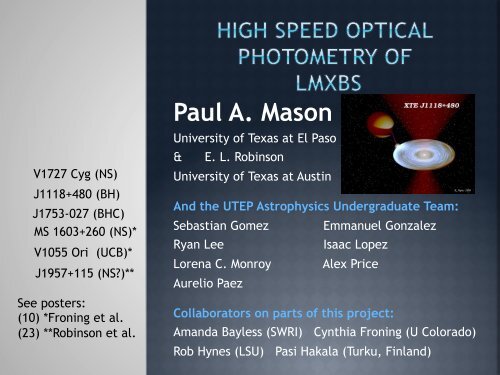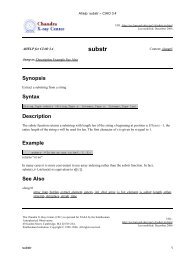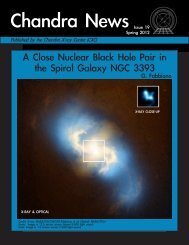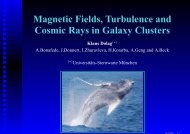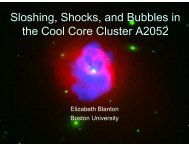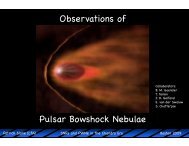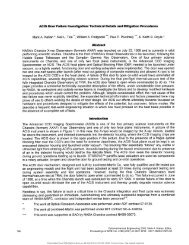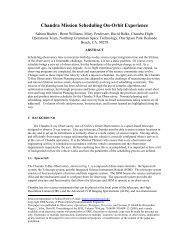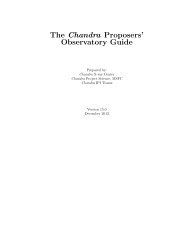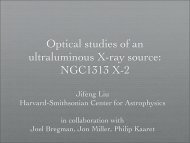Paul A. Mason - Chandra X-Ray Observatory (CXC)
Paul A. Mason - Chandra X-Ray Observatory (CXC)
Paul A. Mason - Chandra X-Ray Observatory (CXC)
You also want an ePaper? Increase the reach of your titles
YUMPU automatically turns print PDFs into web optimized ePapers that Google loves.
V1727 Cyg (NS)<br />
J1118+480 (BH)<br />
J1753-027 (BHC)<br />
MS 1603+260 (NS)*<br />
V1055 Ori (UCB)*<br />
J1957+115 (NS?)**<br />
See posters:<br />
(10) *Froning et al.<br />
(23) **Robinson et al.<br />
<strong>Paul</strong> A. <strong>Mason</strong><br />
University of Texas at El Paso<br />
& E. L. Robinson<br />
University of Texas at Austin<br />
And the UTEP Astrophysics Undergraduate Team:<br />
Sebastian Gomez Emmanuel Gonzalez<br />
Ryan Lee Isaac Lopez<br />
Lorena C. Monroy Alex Price<br />
Aurelio Paez<br />
Collaborators on parts of this project:<br />
Amanda Bayless (SWRI) Cynthia Froning (U Colorado)<br />
Rob Hynes (LSU) Pasi Hakala (Turku, Finland)
Telescopes: 2.1-m and 2.7-m telescopes of McDonald<br />
<strong>Observatory</strong>.<br />
CCD Photometry using a broad-band (BVR) filter and usually<br />
1-10s integrations.<br />
Typically, 20-25 nights of data (~4 hours each night) are<br />
obtained.<br />
V1727 Cyg (NS)<br />
J1118+480 (BH)<br />
J1753-027 (BHC)<br />
MS 1603+260 (NS)*<br />
V1055 Ori (UCB)*<br />
J1957+115 (NS?)**<br />
See posters:<br />
(10) *Froning et al.<br />
(23) **Robinson et al.
All Data 19 nights<br />
Power-Spectrum Optical light curve Analysis, is interpreted shown on as three ellipsoidal different variations, scales with reveal likely a single<br />
frequency some x-ray in heating the optical of the photometry, face of the with secondary. aliasing. Minima are nearly<br />
identical.
V1727 Cygni is an LMXB containing a neutron star, currently in<br />
quiesence. Thorstensen (1979) obtained an optical light curve<br />
during outburst and obtained a period of 5.24 hours, interpreted<br />
as the orbital period of the binary. V1727 Cygni is a hierarchical<br />
triple system with an F class star in wide orbit about the close LMXB pair.<br />
Bothwell (2008).<br />
We present the first detection of ellipsoidal variations of the<br />
secondary found at 0.10912971 +/- 0.00000063 days giving an<br />
orbital period of 0.21825942 +/- 0.00000126 days. A tiny<br />
amplitude of 0.00321 +/- 0.00014 in relative intensity is<br />
measured with t 0 at 2455443.67500 +/- 0.00160 HJD (Price et al.<br />
2012).
McDonald <strong>Observatory</strong> 82 in (2.1-m) telescope<br />
Broad-band (BVR) photometry with 10-s time resolution.
J1118+480 is an LMXB containing a black hole, currently in<br />
quiescence. The light curves have a large-amplitude, nearly<br />
sinusoidal, modulation at 1/2 the orbital period that we attribute<br />
to ellipsoidal variations of the secondary star, first seen by Gelino<br />
et al. 2006).<br />
One of the minima in the ellipsoidal variation is deeper than the<br />
other. The maxima are similar in brightness. Flickering amplitude<br />
is highest during the bright phases of the ellipsoidal variations.<br />
The orbital period is P= 0.16993344 +/- 0.00000048 days and the<br />
time of zero crossing (negative to positive) is HJD 2455324.60280<br />
+/- 0.00025 (Monroy et al. 2012). The ephemeris will be further<br />
improved with data in hand.
Swift J1753-027 was discovered with SwiF/BAT aFer an X-‐ray outburst<br />
(Palmer et al., 2005). From its its spectrum and X-‐ray Nming, the compact<br />
star is regarded as a good black hole candidate (e.g., Miller et al. 2006). One<br />
mystery concerning this binary is a reported negaNve Nme-‐lag between<br />
opNcal and X-‐ray photometric data (Zhang et al., 2010). Zurita et al. (2008)<br />
obtained light curves of SwiF J1753.4-‐0126 that, while highly variable,<br />
allowed for the determinaNon of an opNcal period that was aWributed to<br />
the superhump phenomenon. In this model, the accreNon disk is<br />
asymmetric and precesses in the orbital frame of the binary with a period<br />
that appears as a beat period between the orbital period and the<br />
superhump period.<br />
The light curves vary significantly from night-‐to-‐night; yet some disNncNve<br />
features frequently recur, for example a remarkably linear drop to a<br />
minimum. We detect a sharp PDM feature highly consistent with the sharp<br />
feature at 3.245 hr of Zurita et al. (2008), this may be the orbital period of<br />
the binary. We suggest that the superhump period is detected as the broad<br />
feature in the PDM, see Figure 3. With that interpretaNon, the superhump<br />
period has an esNmated coherence Nme of ~18 days.
-1<br />
-1.2<br />
-1.4<br />
-1.6<br />
-1.8<br />
0.8 0.82 0.84 0.86 0.88
0.1<br />
0.08<br />
0.06<br />
0.04<br />
0.02<br />
0<br />
18 19 20 21 22
0.3<br />
0.2<br />
0.1<br />
0<br />
0.5 1 1.5 2 2.5 3
1.5<br />
0.5<br />
1<br />
0<br />
0 0.5 1 1.5
MS 1603+260 has parNal eclipse of the accreNon disk<br />
that are well modeled with an ellipNcal disk and<br />
measure an upper limit to the rate of change of its<br />
orbital period, |P ̇ | < 4.2 × 10−11 (unitless). The light<br />
curve of UW CrB shows opNcal counterparts of type I X-‐<br />
ray bursts. We tabulate the Nmes, orbital phases, and<br />
fluences of 33 bursts and show that the opNcal flux in<br />
the bursts comes primarily from the accreNon disk, not<br />
from the secondary star. The new observaNons are<br />
consistent with a model in which the accreNon disk in<br />
UW CrB is asymmetric and precesses in the prograde<br />
direcNon with a period of ∼ 5.5 days. (<strong>Mason</strong> et al. 2012<br />
submiWed)


